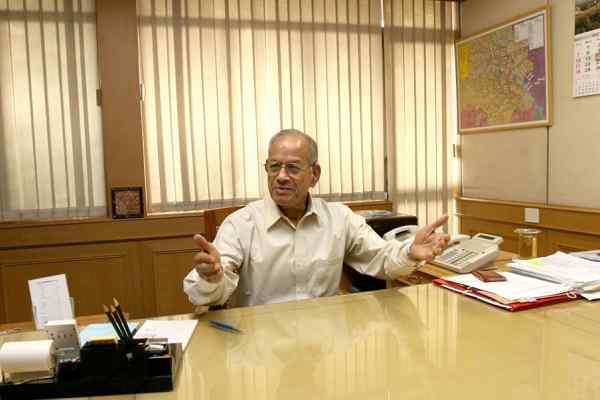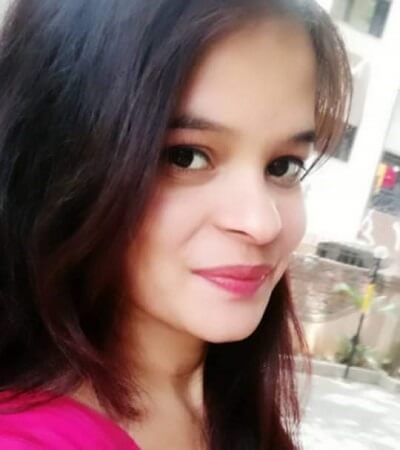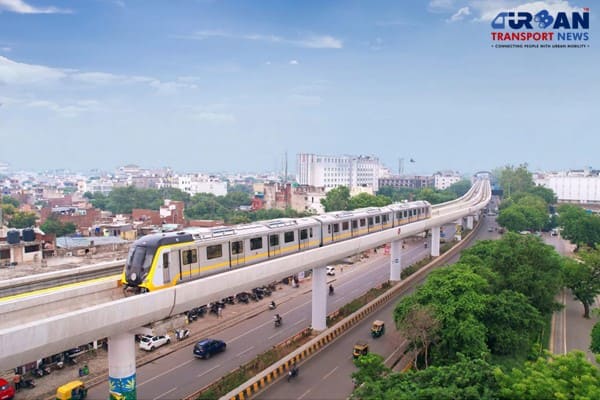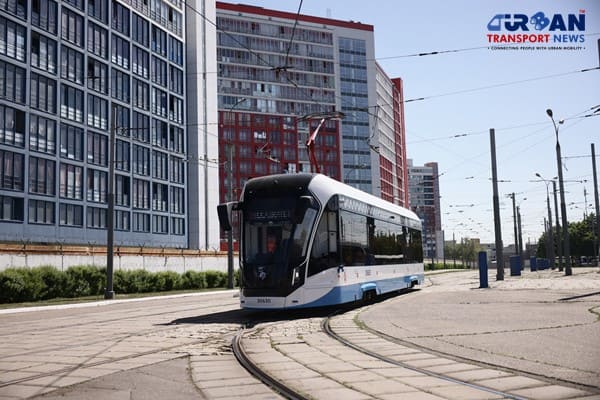 Delhi unveils ambitious Urban Mobility Vision: Luxury Metro Coaches, New Tunnels and Pod Taxi
Delhi unveils ambitious Urban Mobility Vision: Luxury Metro Coaches, New Tunnels and Pod Taxi Qatar approves Saudi Rail Link Agreement, Accelerating Gulf Railway Vision 2030
Qatar approves Saudi Rail Link Agreement, Accelerating Gulf Railway Vision 2030 UP Govt plans to introduce Water Metro services in Ayodhya, Varanasi & Prayagraj
UP Govt plans to introduce Water Metro services in Ayodhya, Varanasi & Prayagraj India’s First Urban Ropeway begins Trial Run in Varanasi, Set to carry 1 Lakh passengers daily
India’s First Urban Ropeway begins Trial Run in Varanasi, Set to carry 1 Lakh passengers daily India and Bhutan to Build First-Ever Rail Link: ₹4,033 Cr Project to Boost Regional Connectivity
India and Bhutan to Build First-Ever Rail Link: ₹4,033 Cr Project to Boost Regional Connectivity Patna to launch Eco-Friendly Water Metro; Trial Run soon between Digha and Kangan Ghats
Patna to launch Eco-Friendly Water Metro; Trial Run soon between Digha and Kangan Ghats Air India Group set to launch Flights Operations from Navi Mumbai International Airport
Air India Group set to launch Flights Operations from Navi Mumbai International Airport Chennai to launch 25-Year Mobility Plan with Unified QR Ticketing and One-App Transit System
Chennai to launch 25-Year Mobility Plan with Unified QR Ticketing and One-App Transit System Kochi Metro bags ₹4.4 crore contract to prepare DPR for Mumbai Water Metro Proejct
Kochi Metro bags ₹4.4 crore contract to prepare DPR for Mumbai Water Metro Proejct Navi Mumbai International Airport set for September launch; IndiGo and Akasa Air to lead Operations
Navi Mumbai International Airport set for September launch; IndiGo and Akasa Air to lead Operations
Exclusive Interview with Dr. E Sreedharan, Technocrate & Urban Transport Leader
 (Dr. E. Sreedharan, Principal Advisor)
(Dr. E. Sreedharan, Principal Advisor)
Dr. E Sreedharan (Elattuvalapil Sreedharan), even at the age of 88 when most people might want to be tending their roses, loves engaging himself with policymakers, urban planners, civic administrators and students, sharing with them experiences gathered over 56 years of his professional life. He travelled across India and sometimes abroad, and is considered a treasure trove of information on urban transportation, Metros, railways, and other infrastructure projects.
In a recent interaction, Sreedharan spoke about his life and times with grace and positivity. Here are edited excerpts:-
You are India’s best-known technocrat, having taken up many challenging projects. What ignites the fire in you even today?
Dr. Elattuvalapil Sreedharan: Somehow there is a great demand for my time and expertise. When the assignment is for the good of society, I don’t pull back. It is the job satisfaction that excites me. My guru Poojya Swami Bhoomananda Tirthaji has told me that as long as I have reasonably good health, I should continue to serve society with the attitude that it is an offering to God.
What are the things that have helped keep you on the move?
Sreedharan: I have always led a disciplined life, getting up very early in the day (4 a.m. formerly, now 5 a.m.) and going to bed by 9 p.m. I usually take a short nap after lunch. I am fastidious about exercise, be it in the open air, or regular yoga. I was a sportsman in my young days, was captain of the college football team. This addiction for regular exercise has remained with me. I was very religious in my early years — shaped by my parents that way. And I moved to spirituality, particularly after the association with my guru. I like austerity and simplicity.
Were you considered for the President’s post in 2017?
Sreedharan: I was never considered for the President’s post by any political party. This was mere kite-flying by the media. Even if I had been considered, I would have declined due to the age factor.
Which metro rail projects are you presently associated with?
Sreedharan: I am directly in charge of the 24-km Kochi Metro. I am a consultant to the U.P. government for the Lucknow, Kanpur and Meerut Metros. Likewise, I am a consultant to the J&K government for the light metros in Jammu and Srinagar. Last month, I resigned from the U.P. assignment due to time constraints, but the resignation has not been accepted. In addition, officials of Mumbai Metro Line No. 3 and Delhi’s Rapid Rail Transit often consult me for technical guidance. I monitor their progress with regular visits.
Passenger patronage of Delhi Metro is high, but that’s not the case with many others. What might be the solution?
Sreedharan: Most Metros make the mistake of fixing high fares — they adopt the Delhi Metro fare or even higher, in hopes of increasing revenue. Metro is a social service and should not be guided by business considerations alone. Its fares must be affordable, to attract commuters who rely on the road. Also, the other Metros are in the infant stage. Their network must cover most city areas. Ridership will increase only if Metro stations are within half a kilometre of commuter destinations. Link bus services and a common ticketing system must be introduced to provide door-to-door connectivity.
Metro is a social service and should not be guided by business considerations alone. Its fares must be affordable, to attract commuters who rely on the road.
Tell us a little bit about some of your most important projects.
Sreedharan: The restoration of Pamban Bridge was a work thrust on me when I was an executive engineer at Southern Railway at the age of 32. I was able to complete the task in 46 days, as against the six-month deadline. This was a record and made possible by adopting innovative engineering methods. The 760-km Konkan Railway, which goes along the most difficult terrains ever encountered in the history of railway construction in India, was completed in seven years. This was possible mainly due to financial engineering and the adoption of superior technology.
Delhi Metro, again, was thrust on me but I was able to make it an astounding success due to teamwork and a unique work culture. In all these projects, I was single-minded in my approach and did not succumb to political and bureaucratic pressures. My philosophy was “performance is the best publicity”. I was able to get my way in these projects because of the unparalleled success of my previous projects.
What could be a sustainable solution to the maddening traffic snarls and chaos in urban India, which impose a heavy toll in the form of pollution, accidents and wastage of time?
Sreedharan: Many people would switch from private vehicles to public transport if they were convenient, safe, reliable and affordable. The government must introduce disincentives in the form of an increase in road tax, the surcharge on fuel, high parking fees, and so on, to increase the patronage of public transport.
You have always advocated the appointment of technocrats in crucial government posts held by civil servants. The Centre has now begun direct recruitment to such posts, overlooking IAS officers.
Sreedharan: The Indian bureaucracy as it exists today is a sad legacy of the British days. To believe that a civil service officer will fit all roles is wrong. Specialisation is a must, especially in these days of fast-changing technology. Proven technocrats must be posted in such fields. Sadly, politicians prefer generalists and they sideline technocrats.
As President of the Foundation for Restoration of National Values (FRNV), what is being done to ensure value-based development in the country?
Sreedharan: FRNV has not been able to achieve much in the last 11 years of its existence. Our flagship program is value-based education so that individually and collectively, people have a persuasion to be honest, patriotic and show concern for society. Education being a State subject, we have not been able to achieve much in this area. Fortunately, the new draft education policy contained in the Kasturirangan report lays great emphasis on value-based education at all levels.
Is spending billions on bullet trains worth it? Or are semi-high-speed corridors a way out?
Sreedharan: High-speed trains are necessary for a vast country like ours. But they are expensive. The country committed a mistake by going in for dedicated railway freight corridors at a huge expense instead of going for dedicated high-speed passenger corridors, which would have released sufficient capacity in the existing rail system for freight traffic. It is still not too late to convert freight corridors to passenger corridors. The cost difference between bullet train corridors and semi-high-speed corridors is not much. Adopting semi-high-speed corridors will again be a mistake, which cannot be corrected later.
The country committed a mistake by going in for dedicated railway freight corridors at huge expense instead of going for dedicated high-speed passenger corridors, which would have released sufficient capacity in the existing rail system for freight traffic. It is still not too late to convert freight corridors to passenger corridors. The cost difference between bullet train corridors and semi-high-speed corridors is not much. Adopting semi-high-speed corridors will again be a mistake, which cannot be corrected later.
Metro Rail is considered very expensive. Does it have any cost-effective alternative?
Sreedharan: Metro Rail is no doubt very expensive; it costs ₹250 crore per km for the elevated corridor and ₹450 crores for underground rail. But its capacity is anything from 45,000 to 90,000 persons per direction per hour. An alternative to such a high-capacity transport is the suburban railway system, but it cannot substitute for an urban mass rapid transport system. Cheaper options like Bus Rapid Transit, Light Rapid Transit, and tramways have lower passenger capacities. Roads would have to be widened for them and this is equally expensive.






